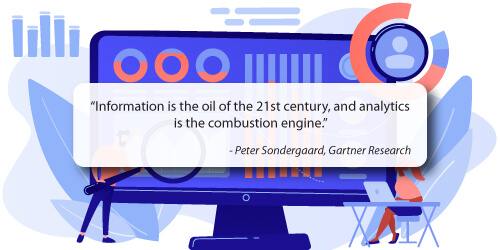94 zettabytes. That's how much data experts predict humans will produce and consume by the end of 2022*. Meanwhile, 463 exabytes of data will be generated each day by people as of 2025. Now imagine what you and other retailers could do if you had access to such data and information. The possibilities are endless, but we know you could build a better business based on keen insight.

Unfortunately, understanding this data is not enough - you have to be able to make decisions based on these insights and apply them to the areas of your business that matter most. POS data, for example, will help you understand which products your customers prefer, which price they are willing to pay, and the rate of these products moving off your shelves.
But as helpful as this data may seem, you can still make a mistake by neglecting it in areas of vital importance, like merchandise selection – the selection of which products you would like to place on offer in specific areas during certain periods.

1. Data helps you build accurate consumer decision trees
How do you know what merchandise to select for your stores? One thing is clear - you can't guess or go with your gut instinct. Yes, in some cases, it might work, but even if it does, it's unlikely to work for long.
Instead, it's better to go with a calculated approach. Such an approach toward your merchandise selection is only possible if you include consumer decision tree classifications.
The good news is that an accurate product classification is no more than a few data entries.
Here's an example:
A product might fall within the Coffee category. It also falls in the Instant Coffee subcategory and Decaffeinated Instant Coffee segment. While it's no more than three data fields, they are crucial.
Typically, if you fall into the highly calculated camp, a methodology to follow would look like this:
- A database which includes both internal POS data and external market data. This forms the foundation of your decisions;
- A logical set of calculations selected for each category; and
- The selected calculations are applied to the subcategory, segment or subsegment. This allows you to determine the ideal merchandise selection for each level of your consumer decision tree.
Of course, clean and classified data isn’t the only fundament of an efficient consumer decision tree. We unpack a handful of others here. However, considering a consumer decision tree depicts the decision-making process your customers undertake when they buy anything in your store, retail data is a must.

2. Merchandise selection depends on data-driven category management elements
If you want to experience success, it's never a case of doing one thing and hoping it will work. Instead, you have to have several pieces moving simultaneously to achieve your objectives. It helps when these various pieces all work together.
That's what category management is about - it involves several moving pieces that rely on each other to achieve various objectives and efficiencies. As a result, you can offer the right product at the right place and time to your customers at the right price. However, remove one piece, and it all falls apart.

As we explain in this article - while category management has a process that consists of separate and individual steps - each function is still interdependent on the other. Without this interdependence, you will struggle to select the merchandise that your customers want to buy.

3. Data helps you avoid the risk of missing opportunities
Your primary goal with merchandise selection is to maximise sales and boost customer satisfaction. There are also many factors to consider when choosing your products, such as your budget, available shelf space, and seasonality.
Another is consumer trends. When it comes to capitalising on opportunities, consumer trends are critical.
Fortunately, there is more good news - you can spot consumer trends within your POS data.
If your data is in order and your product classifications are up to date - see our point on consumer decision trees above - it becomes easy to understand trends. More importantly, you can spot increased interest in a subcategory, segment or subsegment and make necessary decisions.
Let's say, for example, you conduct thorough data analysis for a particular category. And you notice that there has been consistent sales growth for a segment within the grouping. That may indicate that you should consider allocating more space for the product to maximise your sales.
Not only are you maximising your sales because people are buying the item, but you're pleasing shoppers because you're providing them with what they want.
Now imagine choosing what merchandise to display without this knowledge. Without this data, you're in danger of never spotting the opportunity in the first place and stocking items that no one wants to buy. What could make that worse? It's when you look over at your competitor and notice they're enjoying a recent boost in their sales.

4. Data helps you to negate poor shopping experiences
It goes without saying - you're always looking for a competitive advantage. But that's expected if you consider shoppers are savvier and have higher expectations while competition increases.
Both of these factors impact your ability to provide the best selection of merchandise at the right time and price to match customer expectations.

One way to negate that and any potentially poor shopping experience is to embrace new tools and strategies. Fortunately, we live in an era where technology allows us to collect several datasets and gather insights to make better business decisions. That's regardless of industry, but even more so for you if you work in retail.
For example, a customer walks into your store to buy a product. However, you no longer carry the item and they are not willing to buy something else. They'll leave your store to look elsewhere, and you've lost the sale.
If it happens a few times, they might never come back. And it's because you failed to look at your data and understand what you should stock to meet customer demand.

Conclusion
Merchandise selection is a tedious and data-intensive process. However, with the right tools, you can gather, analyse and visualise data to assist you with choosing the best set of products. That allows you to meet consumer demand head-on and maximise your sales.
Are you looking for advice or need a category management solution to help you maximise your sales potential while please your customers? Book your complimentary consultation with a DotActiv expert today, and we'll show you how you can achieve that and more. You can also browse our various software editions and services on our online store.
*This article was updated on 29 September 2022.


